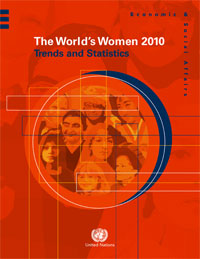 |
THE WORLD'S WOMEN 2010: TRENDS AND STATISTICS
New York, United Nations, 2010, 284 pages
|
http://unstats.un.org/unsd/demographic/products/Worldswomen/WW_full%20report_color.pdf
Издание "Женщины мира в 2010 году: тенденции и
статистика" - это пятый выпуск в серии "Женщин мира".
Последний выпуск подчеркивает различия в положении женщин и мужчин
в восьми областях - население и семья, здравоохранение, образование,
работа, власть и принятие решений, насилие в отношении женщин, окружающая
среды и бедность. Анализ в основном базируются на статистических
данных из международных и национальных статистических источников.
Широкий выбор статистических данных и показателей на уровне стран
представлены в статистическом приложении к докладу.
Публикация "Женщины мира в 2010" показывает,
что достигнут прогресс в некоторых областях гендерного равенства,
таких как прием в школы, здравоохранение и участие в экономической
деятельности. В то же время доклад показывает, что многое еще предстоит
сделать для ликвидации разрыва между полами в таких важных областях,
как энергетика и принятия решений и насилия в отношении женщин.
Table of contents
Message from the Secretary-General
Preface
Prepared by the United Nations Statistics Division
Executive summary
Technical note
1. Population and families
Introduction
A. General population patterns
1. Growth and geographical distribution
2. Population distribution by sex
3. Fertility
4. Ageing
5. International migration
B. Families
1. Marriages and unions
2. Family responsibilities
3. Family and work
2. Health
Introduction
A. Life expectancy at birth
1. Levels of and trends in life expectancy at birth
2. Sex differentials in life expectancy at the country level
B. Causes of death
1. Deaths grouped by broad causes
2. Leading causes of death
3. Cancer morbidity and mortality
C. Morbidity and health risk factors
1. Alcohol consumption
2. Tobacco use
3. Obesity
4. Diabetes
D. HIV and AIDS
1. Prevalence of HIV/AIDS
2. Knowledge of HIV
E. Reproductive health
1. Prenatal and delivery care
2. Maternal mortality
3. Infertility and childlessness of women
4. Contraceptive use
5. Induced abortions
F. Health of children
1. Mortality among children under 5
2. Underweight
3. Immunization
3. Education
Introduction
A. Educational outcomes
1. Literacy
2. Educational attainment
B. Participation in education
1. Primary education
Participation in primary education
Out-of-school children
School progression
2. Secondary education
Participation in secondary education
Participation in technical and vocational education and training
(TVET)
3. Tertiary education
Participation in tertiary education
Tertiary enrolment by field of study
C. Teaching staff
D. Scientific and technological knowledge
1. Research and development
2. Decision-making in research and development
3. Gender digital divide
4. Work
Introduction
A. Women and men in the labour force
1. Labour force participation of women and men
2. Labour force participation across age groups
Trends in labour force participation across age groups
Age patterns of labour force participation
3. Unemployment
Adult unemployment
Youth unemployment
B. Employment conditions of women and men
1. Economic sector of employment
2. Status in employment
3. The informal sector and informal employment
4. Occupational segregation
5. Part-time work
6. Gender pay gap
C. Reconciliation of work and family life
1. Sharing of domestic work
2. Combining family responsibilities with employment
3. Maternity and paternity leave and related benefits
Maternity leave and related benefits
Paternity leave
D. Child labour
1. Child employment and child labour
The magnitude of child employment and child labour
Economic sector of employment of girls and boys
2. Unpaid housework
3. Children's work and education
5. Power and decision-making
Introduction
A. Politics and governance
1. Representation in national parliament
Levels and trends
Presiding officers
Candidacy and election
The use of gender quotas
2. Heads of State or Government
3. Ministers
4. Local governments
B. The judiciary
1. National courts
2. International courts
C. Civil service
1. Senior administrators
2. Women and men in the United Nations
D. The private sector
1. Corporate boards
2. Chief executives
6. Violence against women
Introduction
A. Statistical methodology
1. Development of global statistical indicators
2. Administrative records as a source of statistics on violence
against women
3. Surveys as a source of statistics on violence against women
B. Prevalence and incidence of violence against women
1. Physical violence against women
Overall physical violence
Intimate partner physical violence
2. Sexual violence against women
3. Femicide
C. Female genital mutilation
D. Women's attitudes towards wife-beating
7. Environment
Introduction
A. Access to water and firewood
1. Access to sources of drinking water
2. Access to firewood
B. Environmental factors with an impact on women's health
1. Access to improved water and sanitation
2. Use of solid fuels for cooking and indoor smoke pollution
Use of solid fuels for cooking
Ventilation factors: outdoor cooking and type of stoves
Time spent cooking and near a fire
3. Natural disasters and their impact on number of female and
male deaths
C. Involvement of women and men in preserving the environment
1. Awareness of environmental problems
2. Participation in environmental decision-making
8. Poverty
Introduction
A. Household-level poverty
1. Poverty data disaggregated by sex
2. Female- and male-headed households
Lone-parent households
One-person households
B. Individual access to and control over resources
1. Inequality in intrahousehold allocation of resources
2. Economic autonomy of women
Access to cash income
Ownership of land and other property
3. Participation in intrahousehold decision-making on spending
Statistical Annex
References
|

